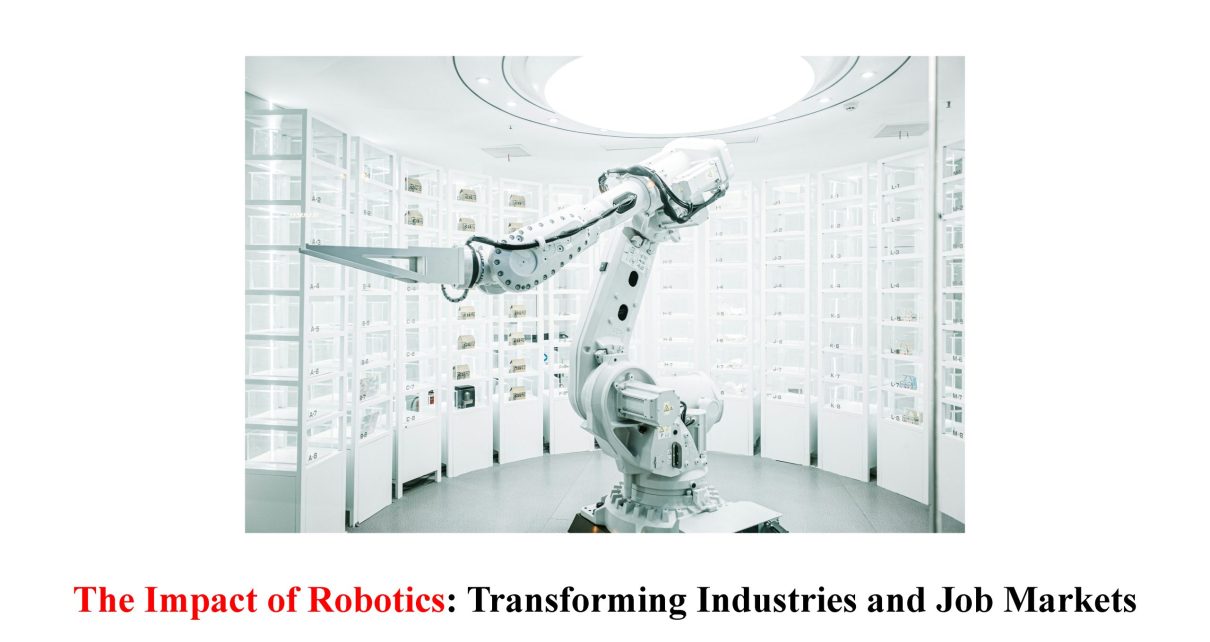Introduction to Robotics
Welcome to the fascinating world of robotics, where science fiction becomes reality and machines come alive! In recent years, robotics has made significant advancements, revolutionizing industries and transforming the way we live and work. From self-driving cars to automated manufacturing processes, robots are now performing tasks that were once only imaginable in our wildest dreams. In this blog post, we will explore the impact of robotics on various industries and job markets. So fasten your seatbelts as we embark on a captivating journey into the exciting realm of robots!
Types of Robotics and Their Applications
Robotics is a vast field that encompasses various types of robots and their applications. From industrial robots to humanoid robots, each type has its unique features and uses.
Industrial robots are the most common type, found in manufacturing plants across industries. These robots are designed to perform repetitive tasks with precision and efficiency, such as assembly line work or welding. They have revolutionized production processes by increasing productivity and reducing human error.
Medical robotics has also made significant advancements in recent years. Surgical robots assist doctors during complex procedures, enabling greater accuracy and minimally invasive techniques. This technology has transformed the healthcare industry by improving patient outcomes and reducing recovery times.
Another fascinating area is autonomous vehicles, which use robotics to navigate without human intervention. Self-driving cars are being developed by major automotive companies worldwide, promising increased safety on the roads while transforming transportation systems.
In addition to these examples, there are many other types of robotics used in agriculture, space exploration, logistics, entertainment, and more. With advancements in artificial intelligence (AI) and machine learning (ML), the potential for robotic applications continues to expand at an exponential rate.
As we witness rapid developments in robotics technology today, it’s important to understand both the advantages and disadvantages associated with its implementation across various sectors
Advantages and Disadvantages of Robotics
Advancements in robotics have brought about numerous advantages across various industries. One major advantage is increased efficiency. Robots can perform tasks faster, more accurately, and tirelessly compared to humans. This boosts productivity and reduces the margin for error.
Another advantage is improved safety. Robots are designed to handle dangerous tasks that may pose risks to human workers. They can operate in extreme conditions such as high temperatures, toxic environments, or confined spaces where it would be unsafe for humans to work.
Cost-effectiveness is also a significant benefit of robotics. While initial investments may be expensive, robots can ultimately reduce labor costs over time by replacing repetitive and mundane tasks performed by humans. This frees up employees’ time for more complex and creative work that adds value to businesses.
On the other hand, there are some disadvantages associated with the increasing use of robotics. Job displacement is one concern often raised when discussing automation and robotics adoption. As robots become more advanced, they have the potential to replace certain jobs traditionally done by humans, leading to unemployment or job insecurity in some sectors.
Moreover, maintenance and repair costs can be substantial when dealing with complex robotic systems. Regular updates and servicing are essential to keep them functioning optimally which requires skilled technicians who specialize in robot maintenance.
Ethical considerations also come into play when using autonomous robots capable of decision-making without human intervention. Questions arise regarding responsibility if a robot causes harm or makes an incorrect judgment that affects individuals or society as a whole.
It’s important for businesses and policymakers alike to carefully navigate these advantages and disadvantages while embracing technological advancements responsibly.
The Evolution of Robotics in Industries
Over the years, robotics has made tremendous strides in transforming various industries. From manufacturing to healthcare, agriculture to logistics, robots have become an integral part of many sectors.
In the early stages, robots were primarily used for repetitive and dangerous tasks that humans found tedious or risky. However, with advancements in technology and artificial intelligence (AI), robots have become more intelligent and versatile.
One significant development is the integration of sensors and cameras into robotic systems. This enables them to perceive their surroundings accurately and make informed decisions based on real-time data. As a result, robots can now perform complex tasks such as object recognition, autonomous navigation, and even human interaction.
Moreover, collaborative robots or cobots have emerged as a game-changer in many industries. These robots work alongside humans safely without the need for safety barriers. They are designed to assist workers rather than replace them entirely, enhancing productivity while maintaining job security.
Furthermore, the use of robotics has led to increased efficiency and cost-effectiveness in industries like manufacturing. Robots can operate continuously without fatigue or breaks and achieve high precision levels that surpass human capabilities.
In addition to traditional industrial applications, robotics has also found its way into emerging fields such as healthcare. Robotic surgical systems enable minimally invasive procedures with greater precision than conventional methods.
The evolution of robotics in industries continues at a rapid pace with exciting possibilities on the horizon. With further advancements expected in AI and automation technologies like machine learning and computer vision, we can anticipate even greater integration of robotics across various sectors.
The Impact on Job Markets
With the rapid advancement of robotics technology, there is no denying that it is having a significant impact on job markets around the world. As robots become more sophisticated and capable of performing complex tasks, certain jobs are becoming obsolete or being replaced by automation.
One area where this impact is particularly evident is in manufacturing. In factories across various industries, robots have taken over repetitive and labor-intensive tasks that were once done by human workers. This has led to increased efficiency and productivity but has also resulted in job losses for many factory employees.
However, it’s important to note that while some jobs may be eliminated, new opportunities are also emerging as a result of robotics. As companies adopt robotic systems, they require skilled technicians and engineers to design, program, operate, and maintain these machines. The demand for individuals with expertise in robotics-related fields is expected to grow rapidly in the coming years.
Moreover, other sectors such as healthcare and logistics are experiencing the positive impacts of robotics as well. Robots can assist doctors with surgeries or perform routine medical procedures with precision and accuracy. In logistics operations, autonomous drones or self-driving vehicles can improve delivery efficiency while reducing costs.
While there will inevitably be job displacement due to automation in certain industries, individuals must adapt their skills accordingly. Investing in education and training programs focused on robotics technology can help workers transition into roles that complement automated systems rather than compete against them.
In conclusion (not concluding), the impact of robotics on job markets cannot be ignored. While there may be concerns about potential job losses due to automation technologies taking over certain tasks previously performed by humans; new opportunities are emerging as well – especially within technical areas related directly or indirectly to robot implementation processes
Preparing for a Future with Robotics
As the field of robotics continues to advance at an astonishing pace, individuals and industries alike need to prepare for a future that will be greatly impacted by this technology. While some may view robots as a threat to human employment, there are steps we can take to adapt and thrive in this new era.
One crucial aspect of preparing for a future with robotics is developing the necessary skills. As automation becomes more prevalent in various industries, it is essential to acquire knowledge and expertise in areas that complement and work alongside robotic systems. This may involve pursuing education or training programs focused on fields such as artificial intelligence, machine learning, or robotics engineering.
Additionally, fostering a culture of innovation within organizations will be vital. Embracing change and encouraging employees to think creatively about how they can collaborate effectively with robots can lead to improved productivity and efficiency. It’s important not to fear robots but rather to see them as tools that can enhance our abilities.
Furthermore, policymakers need to play a role in shaping regulations that facilitate the integration of robotics into different sectors while ensuring ethical considerations are taken into account. Balancing technological progress with social responsibility will be key in creating an environment where humans continue to have meaningful work alongside machines.
Embracing lifelong learning will become increasingly crucial if we want to stay relevant in a world dominated by robotics. The ability to adapt quickly and continuously learn new skills will give individuals the flexibility needed when job markets shift due to automation.
In conclusion (Conclusion section should not include phrases like “In conclusion” or “Overall”), while the impact of robotics on job markets may be significant, preparing for this future begins with embracing change instead of resisting it. By acquiring relevant skills, fostering innovation within organizations, shaping responsible policies around automation implementation, and adopting lifelong learning practices; we can navigate through these changes successfully – ultimately transforming ourselves along with the evolving industry landscape
Conclusion
As we have explored throughout this article, robotics has had a profound impact on various industries and job markets. The advancements in technology have led to the development of different types of robots, each with unique applications and capabilities.
While robotics brings numerous advantages such as increased efficiency, improved safety, and cost savings for businesses, there are also disadvantages to consider. Job displacement is one of the major concerns when it comes to implementing robotic systems. Many routine tasks that were once carried out by humans are now being automated, leading to potential job losses.
However, it’s important not to overlook the fact that robotics also creates new employment opportunities. As industries evolve and adapt to incorporate robotic technologies, new roles emerge that require human expertise in areas like programming, maintenance, supervision, and design.
To prepare for a future with robotics dominating various sectors, individuals need to develop skills that complement these emerging technologies. This could involve pursuing education or training programs related to robotics or acquiring transferable skills such as problem-solving abilities and creativity.
Furthermore, governments and organizations should focus on providing support mechanisms for workers who may be displaced due to automation. Initiatives like retraining programs or creating alternative employment options can help mitigate the negative impacts on job markets caused by the adoption of robotics.
In conclusion (without using those exact words), while the introduction of robots into industries undoubtedly transforms job markets in significant ways – both positive and negative – it ultimately depends on how we adapt and respond as individuals and societies. Embracing technological advancements responsibly while prioritizing skill development and ensuring support mechanisms for affected workers will allow us all to navigate this transformative era more successfully.



